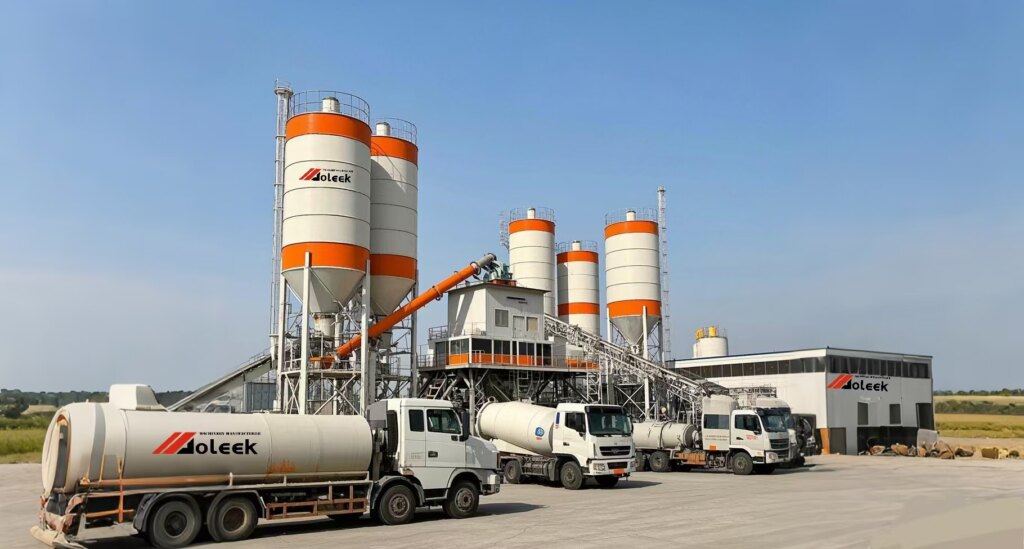Many construction bosses have fallen into such pitfalls when choosing a concrete mixing plant. They may spend 2 million yuan on equipment, yet the actual output is merely 60% of the claimed output. Or, in an attempt to save money, they opt for a smaller model, only to end up paying more in compensation due to project delays… In fact, choosing a mixing plant is akin to assembling a computer. It’s not about getting the most expensive option; rather, the key lies in “custom – tailoring according to requirements”. This article will show you, in the simplest way possible, how to identify the optimal solution in three steps.
Step 1 :Determine the requirements-First, clarify these four questions
1.How much concrete needs to be poured every day?
Customer pain points: Worry about over-purchasing(buying a larger-capacity one resulting in waste)or under-purchasing(buying a smaller-capacity one being insufficient)
Solution:
Simple formula:
Daily production requirement = Maximum single – pour volume × Maximum number of pours per day × 1.2 (safety factor)
Case:
“For example, a developer in a county wants to build 6 18 – storey residential buildings. The slab pouring of each building requires 300m³ of concrete and is completed in 3 times. Then:
Daily requirement = 300m³ × 3 times × 1.2 = 1080m³/day → An HZS120 – type mixing plant (with a theoretical output of 120m³/h) needs to be selected.”
2. What grade of concrete is needed?
| Engineering types | Common grades | Configuration Requirements for the Mixing Station | Cost difference |
| Rural roads | C25-C30 | Self – falling mixer, diesel – powered | $43,000-$72,000 |
| High-rise buildings | C40-C50 | Forced – action mixer, computerized weighing system | $115,000-$170,000 |
| Hydropower station dams | C60+ | Double – horizontal – shaft mixer, equipped with a chiller unit | $215,000+ |
If you’re mainly building rural roads but buy high – end equipment for C50 concrete, it’s like using a Rolls – Royce to transport bricks — the performance is excessive, and you’ll also have to spend on maintenance!
Step 2 :Interpretation of Key Equipment Parameters
1. Deciphering the Model Naming Rules
- HZS120: H stands for concrete, Z represents station – type, S means double – horizontal – shaft, and 120 indicates a theoretical output of 120m³/h.
- Key point: The actual output is usually only 70 – 80% of the nominal output (for example, the actual output of HZS120 is approximately 85 – 100m³ per hour).
2. Three Core Parameters You Must Know
| Parameters | Common Misconceptions | Pit – Avoidance Guide |
| Mixing main engine capacity | “3m³ can hold more than 2m³” | A larger capacity doesn’t necessarily mean higher efficiency. It needs to be matched with the aggregate particle size (for capacities over 3m³, there are requirements for the size of the stones). |
| Discharging height | Neglecting the height of the tanker, resulting in splashing | The standard discharging height is 6 – 8 meters. For tunnel projects, a customized height – increased type is required. |
| Power configuration | Only looking at the power of the main engine while ignoring the total energy consumption | In northern regions, a 15% power margin should be reserved to cope with low – temperature startup. |
Step 3 : Cost analysis
1. Initial investment list
| Project | HZS60(small and medium-sized) | HZS120(medium-sized) |
| Equipment price | $64,000-$93,000 | $114,000-$171,000 |
| Foundation construction | $7,100-$11,400 | $14,000-$21,000 |
| Installation and commissioning | $4,300-$7,100 | $8,500-$14,200 |
| Total | $76,000-$111,000 | $137,000-$20,700 |
2.Hidden Cost Warnings
- Difference in electricity costs:
Forced – action mixers consume 15 – 25 more kilowatt – hours of electricity per hour compared to self – falling mixers.
- Cost of vulnerable parts:
“The mixing blades need to be replaced at least once a year. The unit price of blades for double – horizontal – shaft models is 40% higher than that of single – horizontal – shaft models.”







